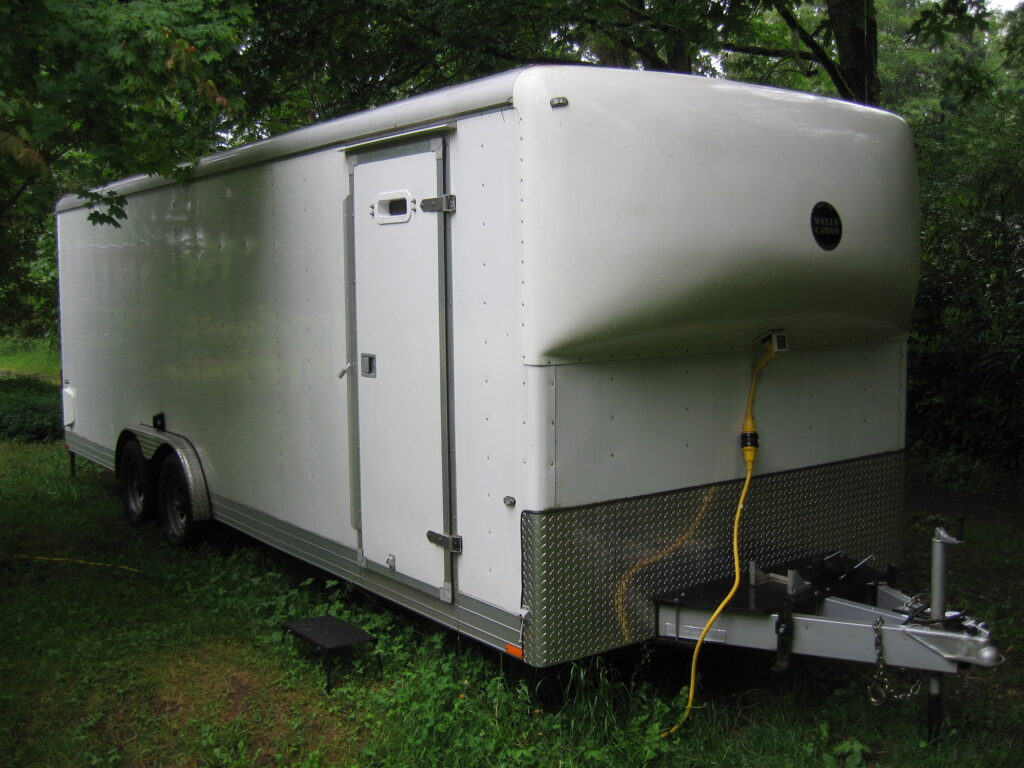
Mobile Lab Reloaded – Wheels within Wheels
For 40 years, I have been building and traveling with mobile labs… from the primitive Winnebiko “computerized recumbent bicycle” to the $1.2 million BEHEMOTH… from Microship trimarans that never quite reached escape velocity to a beautiful 44-foot cruising sailboat… from a 20-foot cargo trailer to a 48-foot geeked-out mobile digitizing lab… and from a power system on a collapsible hand truck to the life-changing beast in the photo above.
This takes computing-on-wheels to an extreme. The information tools of my life are all on a Packout hand truck, and AI wrapped around a NAS lets me chat with my archive. A Home Assistant installation owns some 600 data points, a PC with GPU acts as the front end, a Mac hangs out on an arm, and there are tools for audio/video production. It supports Meshtastic, can run on solar power, has its own network with VPN, and spawns tiny nodes when projects need smarts.
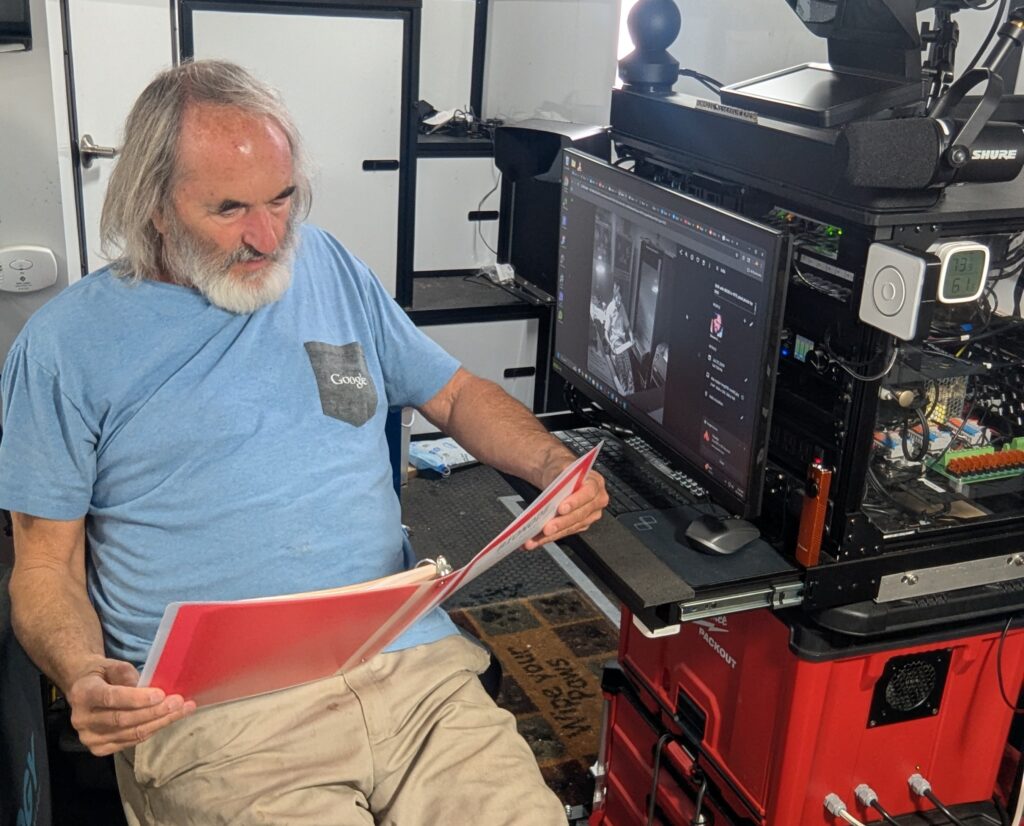
Bionode is my cognitive prosthesis, and if I had to “grab and go” for some reason, this would be the one techie thing… with a single power cord. No boxes of cruft, wall warts, previous devices, mystery cables, or blinky gizmos. It weighs the same as I do, and is the first of a new breed of computing tools.
The key now is to have it actually enable personal mobility… it’s time.
A go-bag for bits
Bionode glides up the ramp of the geeked-out cargo trailer with the help of a winch (wireless control on the handle), landing on a shock-isolated platform. Inertial Measurement Units on the node and nearby wall give us a detailed record of responses to road shock. When it rolls aboard, it assimilates a development environment where it can continue to grow, but still pop out to meet people.
There will be lots to say about that geeky contraption in future posts, but let’s first talk about the wheels. This rig is a 24-foot Wells Cargo trailer that I have had for 20 years, my third from them…
My first version had a bit of fame in MAKE: magazine, sat idle for a few years, then joined the 48-foot media lab to form a compound. (I always wanted one of those, since I already had a manifesto.)

I’ve been dutifully digitizing into my dotage, but Bionode has taken over one end of the lab, surrounded by development clutter, 3D printer, and gizmology awaiting integration. It has its own LAN and Home Assistant server parked inside the domain of another LAN and Home Assistant server, with tailscale managing the layers. It’s time to give it its own space to dispel neural recursion, then go do a speaking tour like those epic home-base quests of yesteryear with mobile bikelab…
Every machine needs a googlable moniker, so I’m dusting off one of my favorite dotcommy neologisms, Nomadness. This was the name of my beloved sailboat, as well as the ‘zine I published back in the ’80s and the listserv of tales archived here. The nautical Nomadness spent a year in La Conner back in 2011 while her future namesake was tucked into a rented garage down the block, yielding one of my favorite photos of the boat-I-should-have-kept.
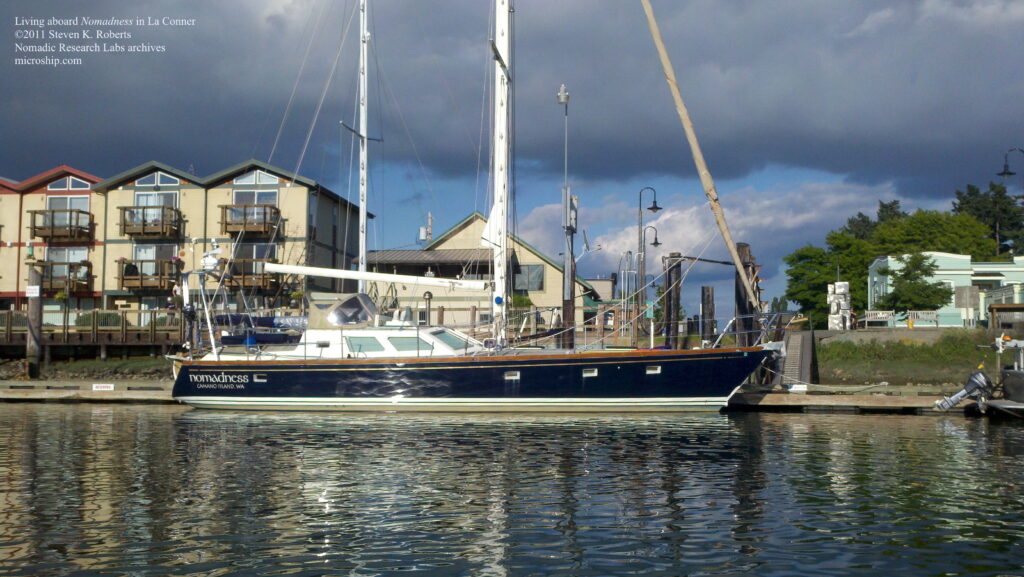
Development Site with a Hint of Comfort
The purpose of this new rig is to provide efficient workspace for Bionode development, fabrication, electronics R&D, and the assembly of geeky machines… all while reliably hosting the core of my computation world in a mobile platform. To do this, it requires a solar power system with shore and generator backups, reliable heating and cooling, a place to sleep, 3D printer, basic life support, packaging that can handle the stresses of driving, inventory management, tool stowage, and a comprehensive monitoring system.
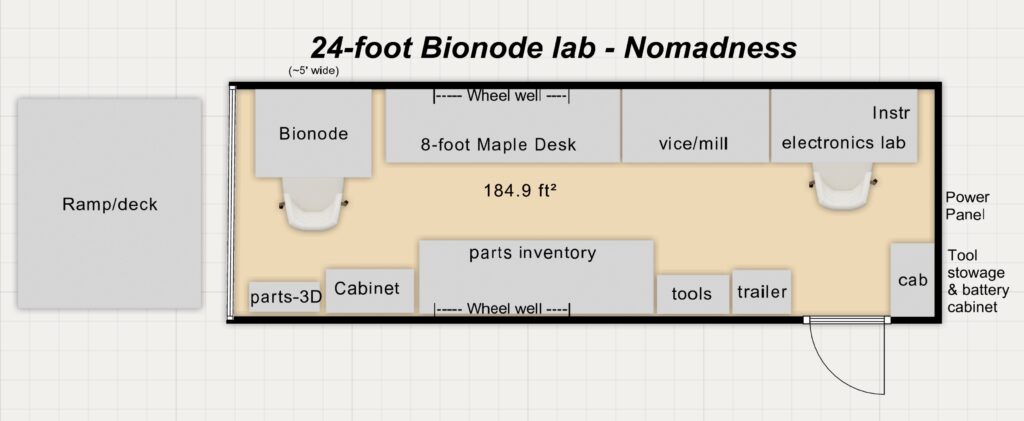
This is a lot to squeeze into 24 feet of cargo trailer, and some of the personal compromises are challenging. It would be really nice to have an indoor shower, for example, but then where would I put the milling machine?
Folding Workbench
This is one of my favorite bits. A convertible couch/bed came with the insanely overpriced 48-foot Bravo digitizing trailer parked next door, and while I have no room for it there, it is perfect here. With a layer of memory foam and some moderately cushy bedding, it’s nice… straddling the wheel well on the port side.
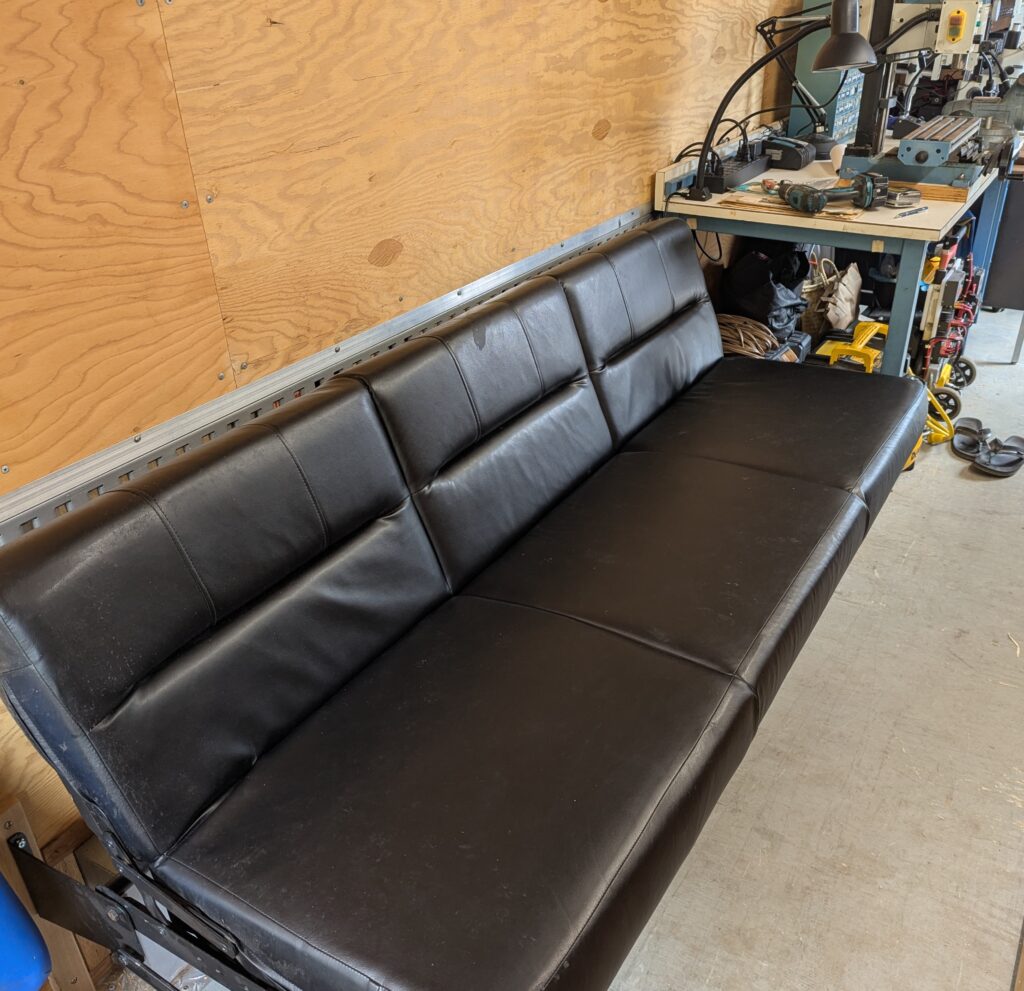
Such indulgences gobble serious wheel estate, however, and if those 24 square feet did nothing else but provide a place to park the bod, it would turn into a mountain of stuff. I needed a way to deploy a solid standing workbench there. Eight feet of 2-inch thick maple oughta do it…
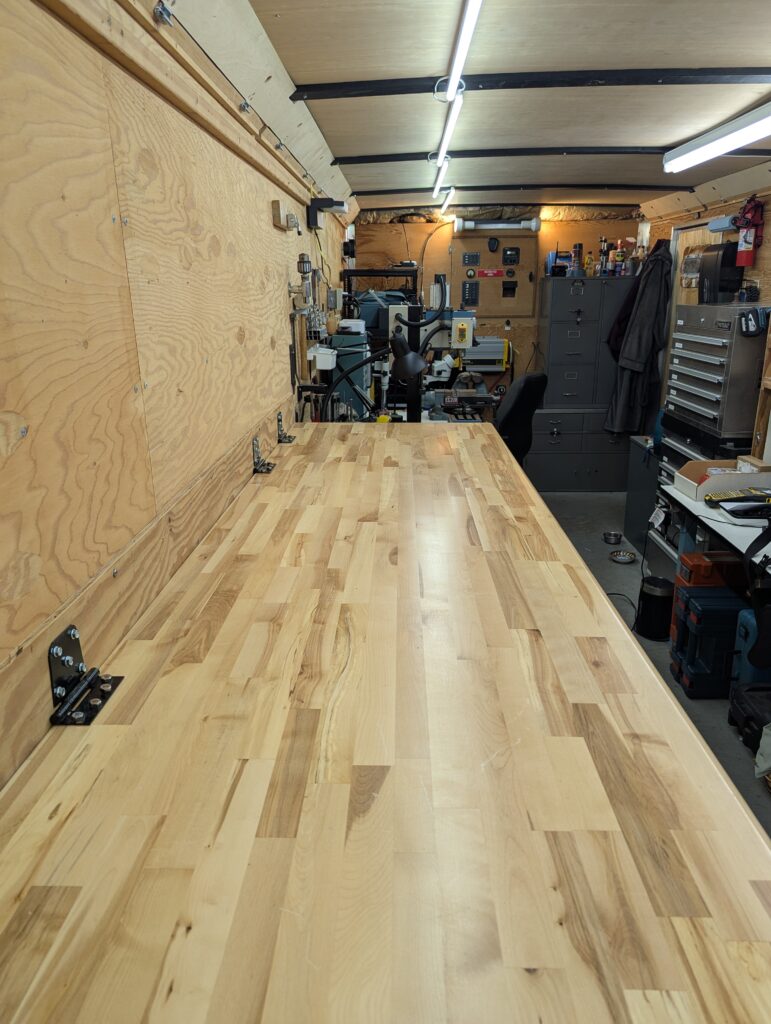
This is a heavy thing, a luxury in a mobile system where we care about GVWR. But there is nothing like a stable flat surface, especially when it is a reference for structures like rackmount frames fabricated with 2020 extrusion. Saggy is not an option; I do enough of that biologically already.
The problem is that we not only need this well supported in use, but MORE so when retracted against the wall… falling could be fatal or worse. When down, as shown above, it is resting on two full-width beams with neoprene pads — one built onto the end of my steel table that holds the milling machine, the other supported in compression by an oak shelving unit bolted to the floor.
I screwed a plywood panel to the wall as a spacer, then mounted four gate hinges at strategic locations that let me use self-drilling screws into the trailer frame hat sections (on 16-inch centers). At first I thought I’d have to rig some 2-part purchase lines with retaining cleats, but a much more elegant solution presented itself.
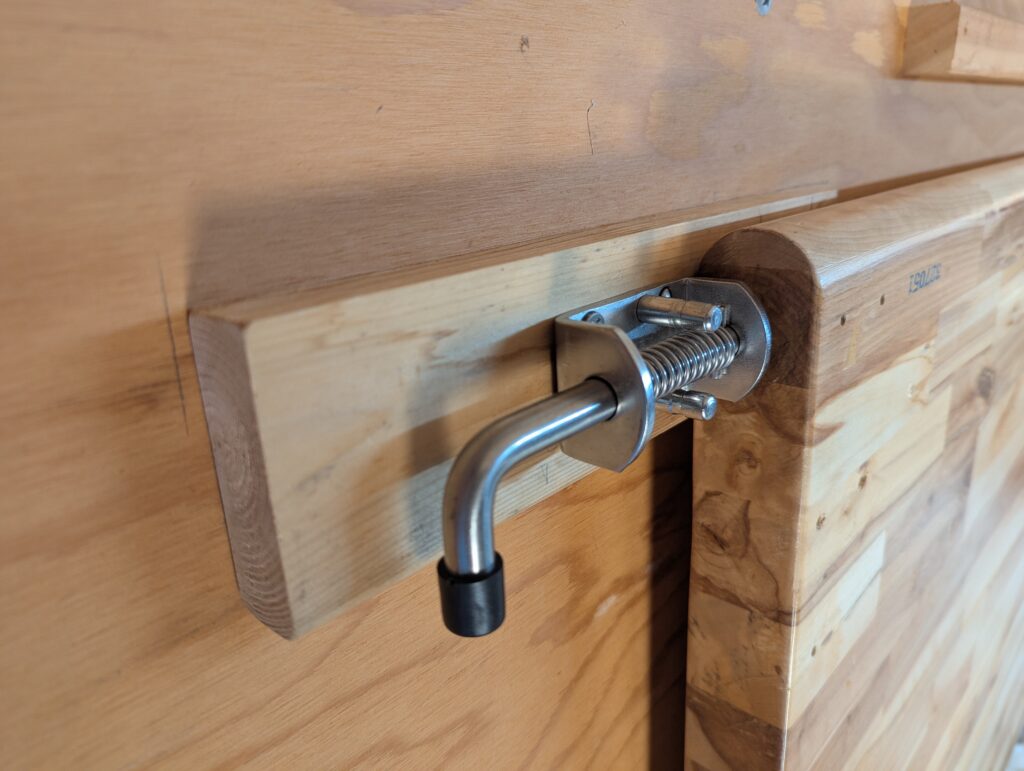
With one of these at each end, we have good redundancy, and it is self-centering with a tapered stainless pin. The test was sleeping under it without being nervous… and it passed. Here is the long view, with mini-mill in the foreground:
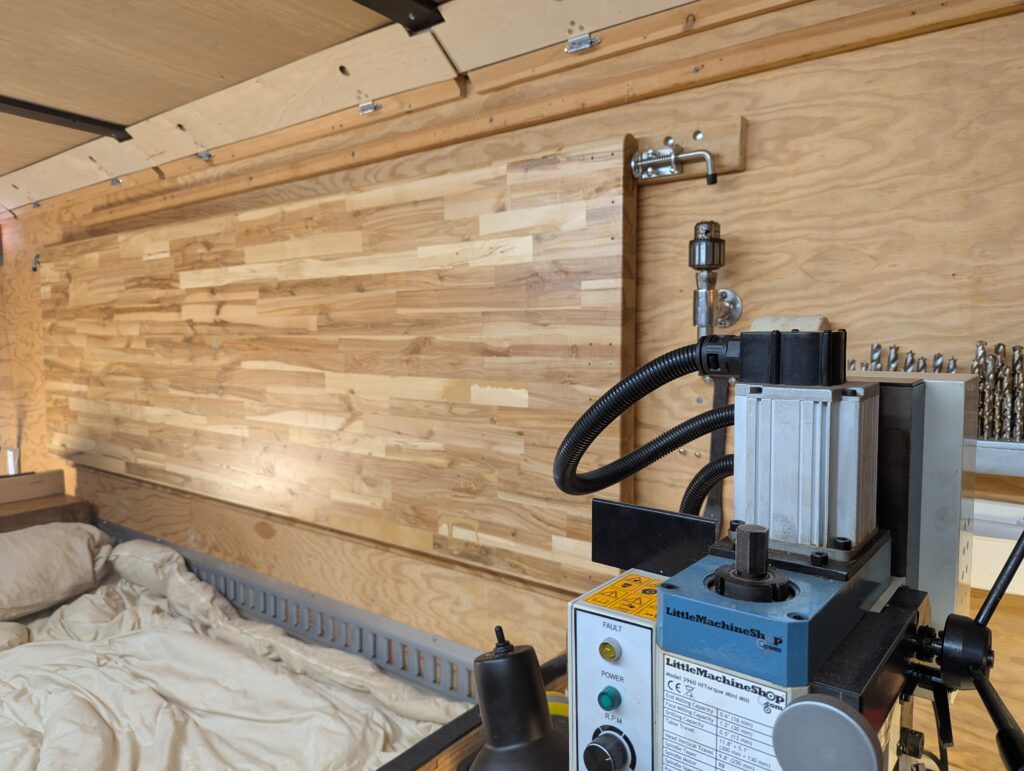
Cecil be ‘da Mill
Speaking of the mill, the zone immediately forward of the sofa/bed/workbench is a steel industrial table with bolted-on milling machine and gorgeous Wilton vise. Machining tools are mounted to the wall behind all this (with my general tools in a stainless cabinet behind me when standing there), and we have excellent task lighting in addition to full-length LED tubes running from bow to stern. The small parts drawer cabinet is stainless hardware, though most inventory is over on the starboard side (as with everything aboard, there is a protocol for keeping that under control when underway).
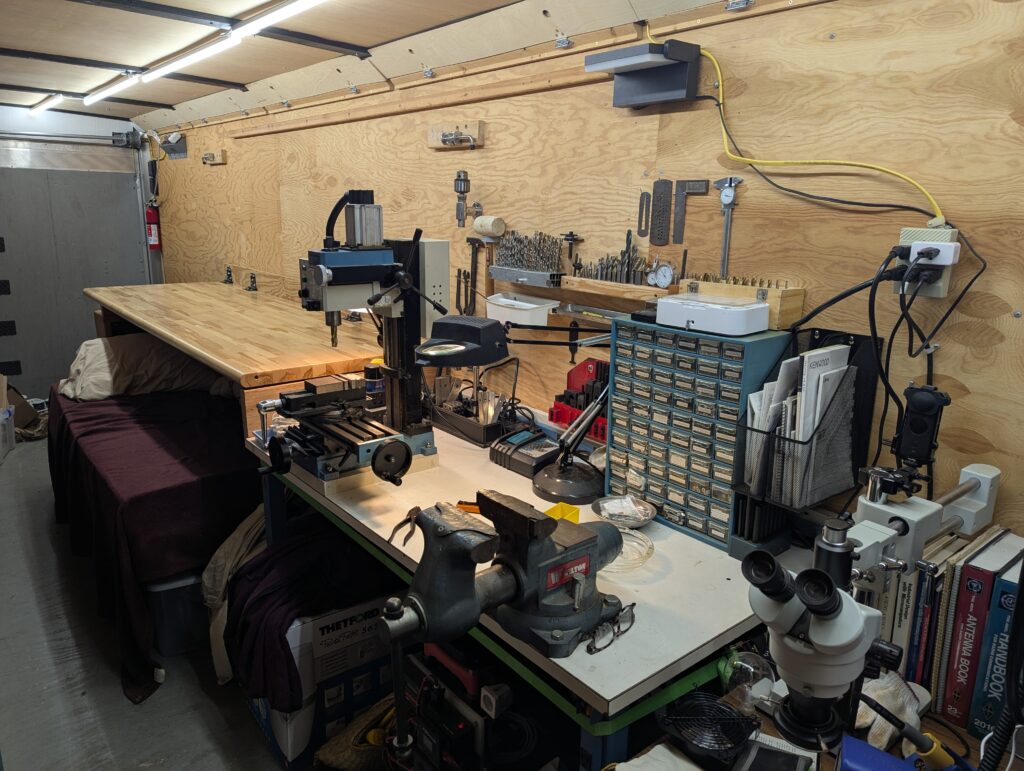
Underneath this bench is an air compressor with 25-foot hose reel (and a 50 foot extension), Shop-vac, spare tire, and my trusty Shacktopus power cart that will be retired for weight savings as soon as the server rack battery and Victron system are installed.
The Zone of Hackage
One might argue that the whole thing is a “zone of hackage,” especially with the shock-isolated Bionode lab-within-a-lab parked on a pad at the stern, but we needed a place for rack-mount essentials, soldering station, microscope, and ham radio. My old steel desk that has lived in this spot before serves as a solid substrate (I know, GVWR-abuse) and the racks are screwed to the wall and each other to provide triangulation. The empty space on the wall above is about to get the mini-split indoor unit.
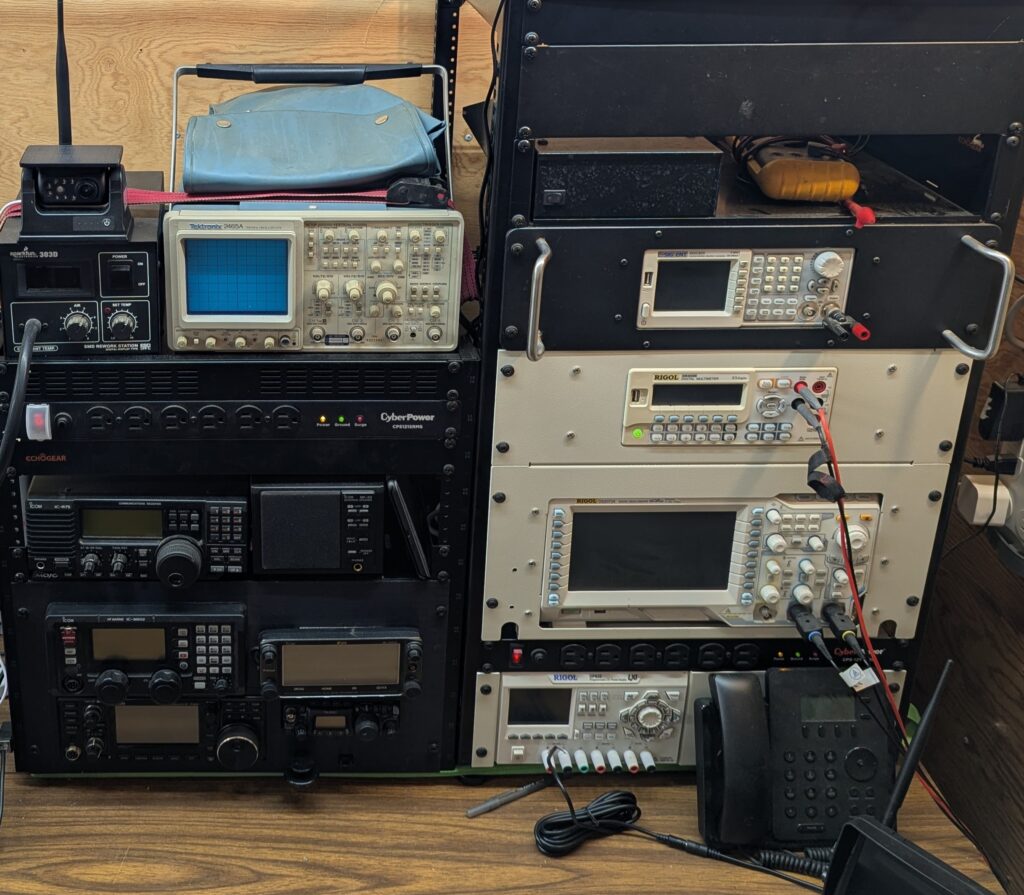
This little cluster of two 19-inch racks gives me the core electronics lab tools — precision power supply, digital oscilloscope with DSP and protocol decoding, digital multimeter, and waveform generator (plus a shelf to park handheld stuff like the Flukes that normally live in a bin). The Tektronix 2465 classic on the left may seem redundant (OK, is redundant) but I love it… an attachment I’ve never had with the Rigol. I’ve had it since the Bikelab at Sun Microsystems 35 years ago, and it followed a lifetime of other Tek scopes that has defined my perception of signals since I was 17. So it is the one I turn to first, usually.
On the left is the ham shack. There is a shortwave receiver that I don’t love as much as my old Hammarlund SP-600, but does the job. Although, with software-defined radio in Bionode plus a machine running here all the time with a Beverage antenna, “radio” is starting to feel retro. (If you want to be amazed, here is a view of my last 24 hours of reception reports, with an antenna directly connected to a port bit. Yah, I know. It is weird.)
That rack needs to be fine-tuned a bit, so to speak; it’s not like I have an antenna farm on the trailer roof, and there are redundancies with three HF rigs of different feature sets (nautical, QRP, and SDR with digital modes). It was easy to move from its previous site, and it will be refined over time.
Other tools at this workstation include stereo zoom microscope with camera, soldering and hot-air rework stations, and general fixturing… mostly this is a place for probing circuits and yakking on the radio. To my right at that position is a wall of Victron power stuff, but I’m saving that since it’s work in progress.
Tools and Inventory
Finally, a key bit of infrastructure… the massive amount of stuff that is needed to build things. This isn’t a simple category, and there is a ton of overlap among tools, instruments, parts, consumables, gizmology, wire, goo, and bits that might come in handy someday. (Still, if a project requires n components, there will be n-1 units in stock.) I stopped trying to create clear boundaries when I realized that some of my life-support items fit right in… this is the glue that holds everything together (or helps cut it apart). The stainless Kobalt tool cabinet in the distance is a key component, as is a gray cabinet at the bow that holds power tools, drills, kits, and dox.
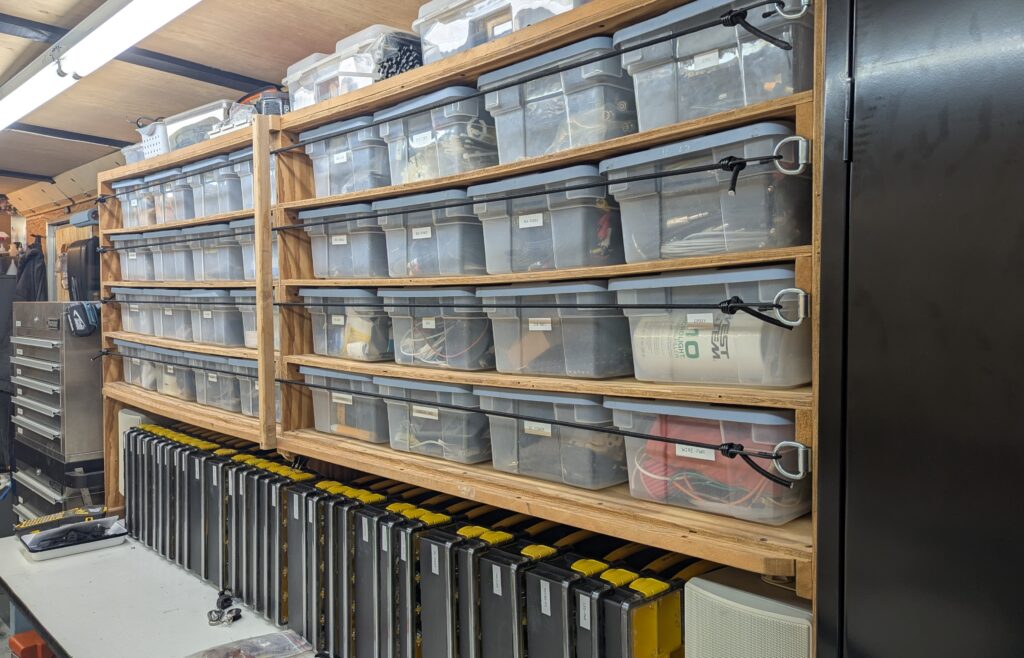
The substrate is an 8-foot steel bench that I’ve had for decades, along with a plywood shelving assembly that I built to handle 32 Rubbermaid bins when I was outfitting a mothership for the speaking tour with BEHEMOTH in 1991. This covered tens of thousands of miles, then migrated to the larger mobile lab a decade later. It is a little saggy, but is a perfect solution to the perennial storage problem (along with those bins that have survived 35 years without cracking).
Underneath them on the desktop, there is a long row of Stanley parts boxes. I love these things, and for years thought I’d build a sort of baker’s rack for them as so many makers have. But a few weeks ago, contemplating the space impact of all this, I realized that thinking of it as a bookshelf instead of a stack is much simpler. Either method avoids the annoying issue of needing the one at the bottom of a pile and trying to get away with yanking it out like that old tablecloth trick…
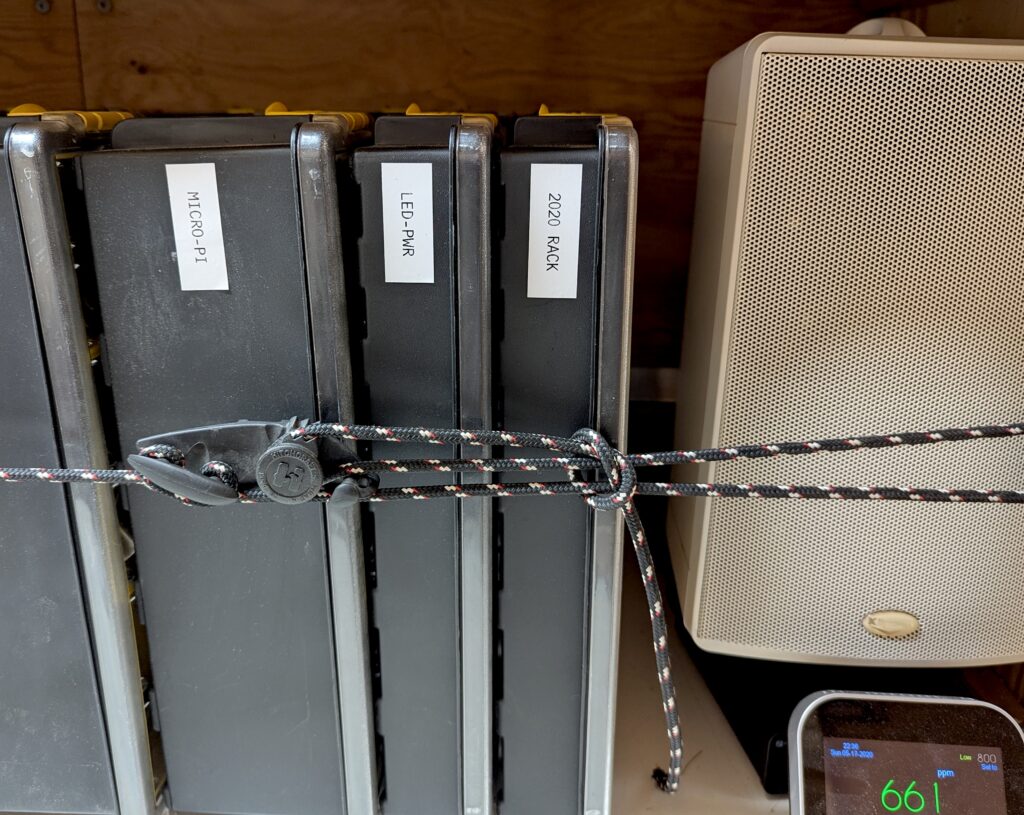
These include heavy batches of hardware, so instead of the bungee cord bin retainers like the upstairs neighbors they have a length of double-braid line with carabiner to padeye at one end, a stand-up block at the other, and 2-part purchase to a Hitchcraft cleat that creates a quick one-handed trucker’s hitch. I love these things, and used them on the other Nomadness to retain the dinghy on the davits.
Underneath this region there is a full-size digital piano in a locking drawer (built 9 years ago for the boat and detailed here), a Porta-Potti (the peeano, of course — learning the first movement of Intestinal Suite #2 in B minor), and stowage for power tool kits and load-equalizing hitch. Tight spaces make for strange bedfellows.
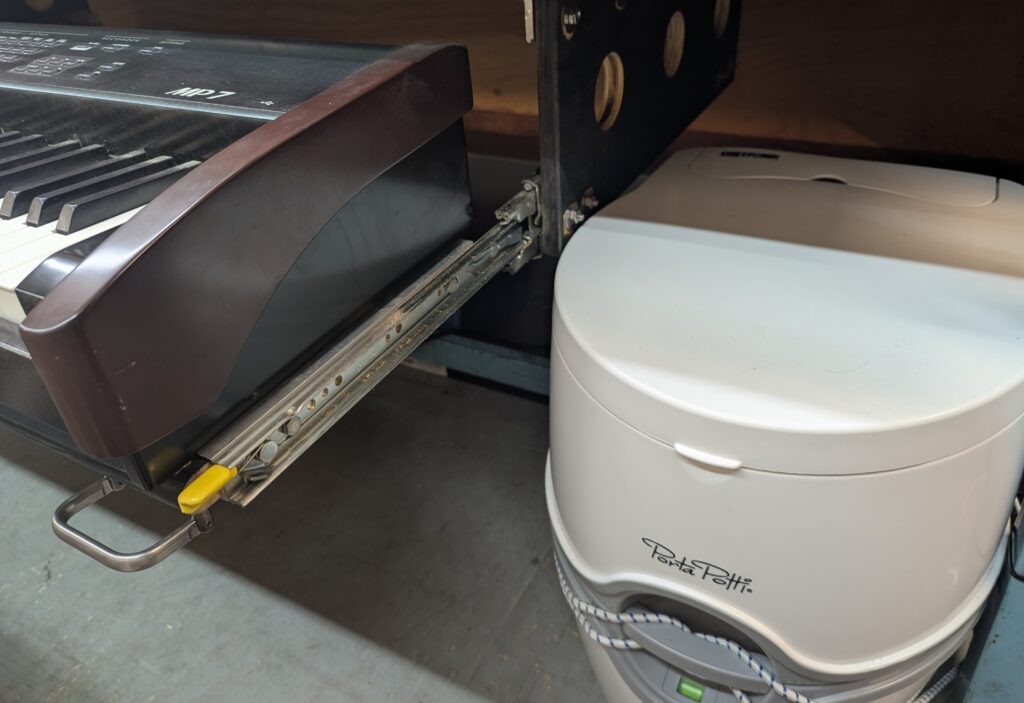
Finally, there is a big black steel locking cabinet aft of all this, followed by an ancient drawer unit at the stern that supports the 3D printer owned by Bionode…
On the Road Again
There’s a lot more to discuss about this rig, and now that we have set the stage with a quick walkthrough I look forward to close-up explorations of HVAC, lighting, Home Assistant applications, video, security, cat management, piano integration, acoustics, life support systems, CG calculations, Bionode loading and shock-isolation platform, video production, insulation, rooftop solar array, the Flooradoora device, comfort, tankage, and what I would do differently if starting over.
In the meantime, there is a maiden voyage looming, with an excursion to Silicon Valley that includes a visit with BEHEMOTH at the Computer History Museum, and in the spirit of my speaking tours half a lifetime ago, I’m putting the word out…
Does your company, school, or event want a geeky show ‘n tell with Bionode on stage, road stories from the technomadic years, and glimpses of the next personal computer? Drop me a line…

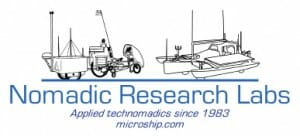
You must be logged in to post a comment.